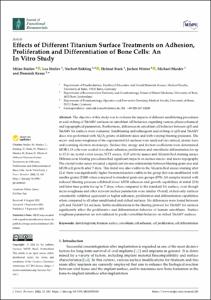Effects of Different Titanium Surface Treatments on Adhesion, Proliferation and Differentiation of Bone CellsAn In Vitro Study

Effects of Different Titanium Surface Treatments on Adhesion, Proliferation and Differentiation of Bone Cells
An In Vitro Study

| dc.contributor.author | Stoilov, Milan | |
| dc.contributor.author | Stoilov, Lea | |
| dc.contributor.author | Enkling, Norbert | |
| dc.contributor.author | Stark, Helmut | |
| dc.contributor.author | Winter, Jochen | |
| dc.contributor.author | Marder, Michael | |
| dc.contributor.author | Kraus, Dominik | |
| dc.date.accessioned | 2023-04-28T12:26:57Z | |
| dc.date.available | 2023-04-28T12:26:57Z | |
| dc.date.issued | 05.09.2022 | |
| dc.identifier.uri | https://hdl.handle.net/20.500.11811/10809 | |
| dc.description.abstract | The objective of this study was to evaluate the impacts of different sandblasting procedures in acid etching of Ti6Al4V surfaces on osteoblast cell behavior, regarding various physicochemical and topographical parameters. Furthermore, differences in osteoblast cell behavior between cpTi and Ti6Al4V SA surfaces were evaluated. Sandblasting and subsequent acid etching of cpTi and Ti6Al4V discs was performed with Al2O3 grains of different sizes and with varying blasting pressures. The micro- and nano-roughness of the experimental SA surfaces were analyzed via confocal, atomic force and scanning electron microscopy. Surface free energy and friction coefficients were determined. hFOB 1.19 cells were seeded to evaluate adhesion, proliferation and osteoblastic differentiation for up to 12 d via crystal violet assays, MTT assays, ALP activity assays and Alizarin Red staining assays. Differences in blasting procedures had significant impacts on surface macro- and micro-topography. The crystal violet assay revealed a significant inverse relationship between blasting grain size and hFOB cell growth after 7 days. This trend was also visible in the Alizarin Red assays staining after 12 d: there was significantly higher biomineralization visible in the group that was sandblasted with smaller grains (F180) when compared to standard-grain-size groups (F70). SA samples treated with reduced blasting pressure exhibited lower hFOB adhesion and growth capabilities at initial (2 h) and later time points for up to 7 days, when compared to the standard SA surface, even though micro-roughness and other relevant surface parameters were similar. Overall, etched-only surfaces consistently exhibited equivalent or higher adhesion, proliferation and differentiation capabilities when compared to all other sandblasted and etched surfaces. No differences were found between cpTi and Ti6Al4V SA surfaces. Subtle modifications in the blasting protocol for Ti6Al4V SA surfaces significantly affect the proliferative and differentiation behavior of human osteoblasts. Surface roughness parameters are not sufficient to predict osteoblast behavior on etched Ti6Al4V surfaces. | en |
| dc.format.extent | 16 | |
| dc.language.iso | eng | |
| dc.rights | Namensnennung 4.0 International | |
| dc.rights.uri | http://creativecommons.org/licenses/by/4.0/ | |
| dc.subject | dental implants | |
| dc.subject | titanium surface | |
| dc.subject | osteoblasts | |
| dc.subject | cell adhesion | |
| dc.subject | cell proliferation | |
| dc.subject | cell differentiation | |
| dc.subject.ddc | 610 Medizin, Gesundheit | |
| dc.title | Effects of Different Titanium Surface Treatments on Adhesion, Proliferation and Differentiation of Bone Cells | |
| dc.title.alternative | An In Vitro Study | |
| dc.type | Wissenschaftlicher Artikel | |
| dc.publisher.name | MDPI | |
| dc.rights.accessRights | openAccess | |
| dcterms.bibliographicCitation.volume | 2022, vol. 13 | |
| dcterms.bibliographicCitation.issue | iss. 3 | |
| dcterms.bibliographicCitation.pagestart | 1 | |
| dcterms.bibliographicCitation.pageend | 16 | |
| dc.relation.doi | https://doi.org/10.3390/jfb13030143 | |
| dcterms.bibliographicCitation.journaltitle | Journal of Functional Biomaterials | |
| ulbbn.pubtype | Zweitveröffentlichung | |
| dc.version | publishedVersion | |
| ulbbn.sponsorship.oaUnifund | OA-Förderung Universität Bonn |
Files in this item
This item appears in the following Collection(s)
-
Publikationen (5)




